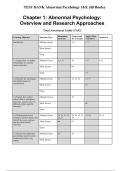TEST BANK Abnormal Psychology 18/E Jill Hooley
Chapter 1: Abnormal Psychology:
Overview and Research Approaches
Total Assessment Guide (TAG)
Remember Understand Apply What
Learning Objective Question Type Analyze It
the Facts the Concepts You Know
Introduction Multiple Choice 3, 4 1, 2
Short Answer
Essay
1.1 Explain how we define Multiple Choice 5, 9, 11 10 7, 8 6, 12
abnormality and classify
mental disorders.
Short Answer 64
Essay 74
1.2 Describe the advantages Multiple Choice 17 13, 14, 18 15, 16
and disadvantages of
classification.
Short Answer 65
Essay
1.3 Explain how culture Multiple Choice 19
affects what is considered
abnormal, and describe two
different culture-specific Short Answer 66
disorders.
Essay
1.4 Distinguish between Multiple Choice 20, 21, 22, 25, 28, 29, 30, 33, 23, 24 27, 32
incidence and prevalence, and 26, 31 34
identify the most common
and prevalent mental Short Answer 68 67
disorders.
Essay
1.5 Discuss why abnormal Multiple Choice 35 36
psychology research can be
conducted in almost any
setting. Short Answer
, Essay
1.6 Describe three different Multiple Choice 37 38
approaches used to gather
information about mental
disorders. Short Answer 70 69
Essay 75
1.7 Explain why a control (or Multiple Choice 40, 42 39, 41 43, 44
comparison group) is
necessary to adequately test a
hypothesis. Short Answer 71
Essay
1.8 Discuss why correlational Multiple Choice 45, 50, 51 46, 47, 48, 49 52 53, 54
research designs are valuable,
even though they cannot be
used to make causal Short Answer
inferences.
Essay 76
1.9 Explain the key features Multiple Choice 55, 57, 58, 59 56, 62 60, 61, 63
of an experimental design.
Short Answer 73 72
Essay
,Chapter 1: Abnormal Psychology: Overview and
Research Approaches
MULTIPLE CHOICE
1. Which of the following individuals would most likely be a subject of specialists in abnormal
psychology?
a. Stacy, a college student who is consistently 15 minutes late to class
b. Jason, a stock trader who rarely leaves his house
c. Misha, a lab assistant who translates the vocal sounds of dolphins
d. Tyree, an athlete who seeks to use visual imagery to improve his rowing technique
Answer: b
Learning Objective: None
Topic: Introduction
Difficulty Level: Moderate
Skill Level: Apply What You Know
APA Learning Objective: 1.1 Describe key concepts, principles, and overarching themes in
psychology.
2. Which of the following is an example of family aggregation?
a. Both Jane and her husband are alcoholics.
b. Jim and John, 21-year-old friends, are both schizophrenics.
c. Karen, her mother, and her grandmother have all been diagnosed with generalized
anxiety disorder.
d. Kim committed suicide, apparently in reaction to her mother’s abuse.
Answer: c
Learning Objective: None
Topic: Introduction
Difficulty Level: Moderate
Skill Level: Apply What You Know
APA Learning Objective: 1.1 Describe key concepts, principles, and overarching themes in
psychology.
3. What does Monique’s case, outlined in the textbook, best illustrate?
a. Abnormal behavior usually produces more distress in others than in the person who
engages in the abnormal behavior.
b. Abnormal behavior covers a wide range of behavioral disturbances.
c. Most people who suffer from abnormal behavior are quickly identified as deviant by
other people.
d. When people suffer from mental disorders, they are unable to work or live
independently.
Answer: b
Learning Objective: None
Topic: Introduction
Difficulty Level: Moderate
, Skill Level: Understand the Concepts
APA Learning Objective: 1.1 Describe key concepts, principles, and overarching themes in
psychology.
4. What does the case of Scott, outlined in the textbook, best illustrate?
a. The problems associated with higher education in America today
b. That homelessness often causes psychopathology
c. That some psychological conditions are “late onset”—that is, initially occurring in
adolescence or young adulthood
d. That lower socioeconomic status is a causal factor of psychosis
Answer: c
Learning Objective: None
Topic: Introduction
Difficulty Level: Easy
Skill Level: Understand the Concepts
APA Learning Objective: 1.1 Describe key concepts, principles, and overarching themes in
psychology.
5. What makes defining abnormality difficult?
a. There are so many types of abnormal behavior that they can’t be accurately described.
b. There is no one behavior that serves to make someone abnormal.
c. Most of us are abnormal much of the time, so we cannot tell what is normal.
d. Criteria for abnormality have yet to be developed.
Answer: b
Learning Objective: 1.1 Explain how we define abnormality and classify mental disorders.
Topic: Indicators of Abnormality
Difficulty Level: Moderate
Skill Level: Remember the Facts
APA Learning Objective: 1.1 Describe key concepts, principles, and overarching themes in
psychology.
6. Which of the following statements accurately describes a characteristic indicator of
abnormality?
a. Subjective distress must be present in order for a behavior, emotion, or thought to be
deemed abnormal.
b. A behavior, emotion, or thought that is statistically rare and desirable is considered
abnormal.
c. Violating the standards of society, particularly when statistically rare, is abnormal.
d. Engaging in highly dangerous activities on a regular basis reflects abnormal behavior.
Answer: c
Learning Objective: 1.1 Explain how we define abnormality and classify mental disorders.
Topic: Indicators of Abnormality
Difficulty Level: Difficult
Skill Level: Analyze It
APA Learning Objective: 1.1 Describe key concepts, principles, and overarching themes in
psychology.




